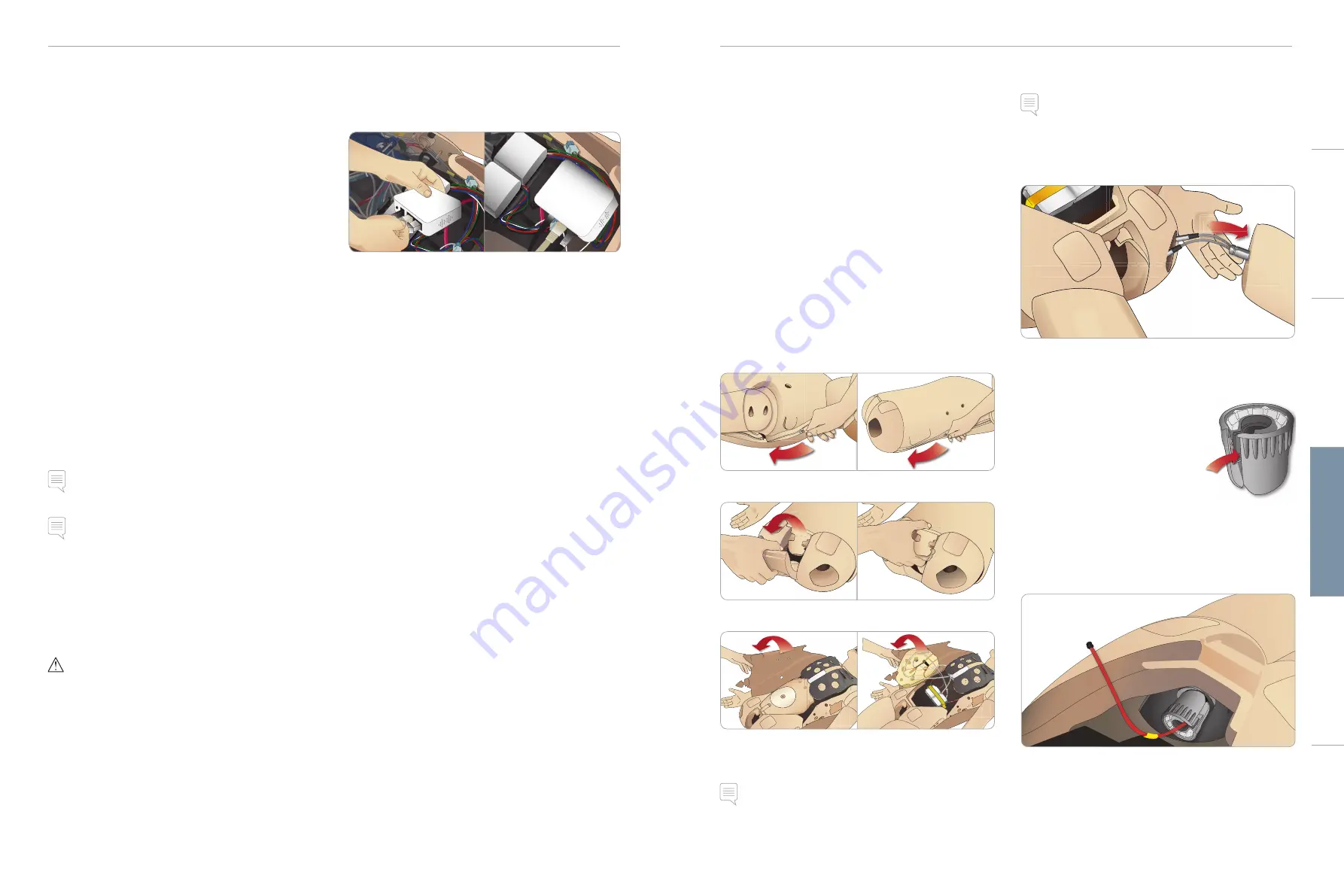
34
35
MAINTENANCE
MAINTENANCE
Installing and Upgrading
SimMan 3G Software
SimMan 3G software comes pre-installed. When updating
LLEAP, check if updates for Patient Monitor, SimDesigner and
SessionViewer/SimView are also available.
All available software must be updated at the same time. Install or
update the software in the following order:
1 Update the Software on the instructor PC. See
Instructor PC and
Patient Monitor PC
section.
2 Update the Software on the Patient Monitor PC. See
Instructor
PC and Patient Monitor PC
section.
3 Update the Software on the Patient Simulator. See
Simulator
Firmware & Network Fixer
section.
Instructor PC and Patient Monitor PC
1 Power on computer and ensure no SimMan 3G applications are
running.
2 DO NOT uninstall the SimMan 3G software from your
computer. Visit www.laerdal.com/downloads to download the
latest version of SimMan 3G and Laerdal Debrief Viewer. Select
SimMan 3G and press “Click to Download” then follow the
on-screen instructions to install.
3 In the installation menu – click the <Install SimMan 3G
Software> button once. This will start copying files to your
computer.
Note: The copying process takes approximately 2-3 minutes. Once
the copying process has finished, please follow instructions in the
installation wizard.
Note: The software will update automatically if started whilst
connected to the Internet.
Simulator Firmware & Network Fixer
The Patient Simulator software update is handled by the Simulator
Firmware & Network Fixer application. To update the Patient
Simulator software, follow the instructions in
Simulator Firmware &
Network Fixer Help.
Caution: Do not switch OFF the Patient Simulator while updating
the Patient Simulator Software.
Removing or Changing Router
The router may be changed or removed. Turn off the Patient
Simulator before doing so.
Open the pelvis and locate the router. Remove the two Ethernet
cables and black power cable.
If you would like to operate the Patient Simulator without a router,
then attach a through-adapter between the two Ethernet cables.
If you would like to install a new router, attach the power cable to
the DC plug and the Ethernet cables back into the router again.
Opening the Torso
Open the Patient Simulator torso for the following procedures:
Attaching or Replacing Limbs
−
Attaching or dismantling the Patient Simulator legs and arms
−
Exchanging default arms for optional IV or trauma arms
Maintenance Tasks
−
Changing the Patient Simulator batteries
−
Replacing the pneumothorax bladders, chest-rise bladders, lung
bladders, IO modules and chest drain modules
−
Replacing the Torso Skin
−
Performing a general inspection
−
Removing WLAN adapter
To Open the Torso Skin
1 Unzip the zippers on the Patient Simulator’s left shoulder and
torso.
2 Remove the genitalia pad and release the skin flap from the pelvis.
3 Fold the Torso Skin over to one side.
4 Open the Stomach Foam to one side, taking care not to tug on
the connecting tubes and cables.
Note: DO NOT disconnect the tubes and cables connecting the
stomach foam to the Patient Simulator.
5 Replace the Stomach Foam and close the Torso Skin, perform
steps 1- 4 in reverse.
Attaching the Left Leg
Note: Assemble the Patient Simulator on a large flat surface. Attach
the left leg before the right leg.
Open the torso to access the hip joint connectors. To open the
torso follow steps 1 – 4,
Opening the Torso.
1 Align the left leg bolt and cables with the pelvis socket.
2 Feed the leg bolt and cables through the socket and into the
torso. Do not pull the leg by the cables and/or tubes.
3 Carefully push the leg in towards the pelvis to form a snug fit.
Hip joint connector with side slot for
inserting cables and tubes (shown right)
4 Position the connector with rounded
end facing downward. Place the leg
cables and tubes into the side slot of
the connector.
5 Slide the connector downwards along
the tubes and cables and onto the leg bolt. Ensure that the nut
and bolt are aligned, and that all cables and tubes are secured
within the connector.
6 Screw the connector onto the leg bolt. Avoid twisting the tubes
and cables. Tighten the connector so that the leg is able to rotate
freely around the hip joint connector.
7 Connect the corresponding leg tubes and cables as shown in the
table on the following page.
Cautions
and
W
arnings
Featur
es
Setup
Maintenance
Spar
e Par
ts
Tr
oubleshooting





















